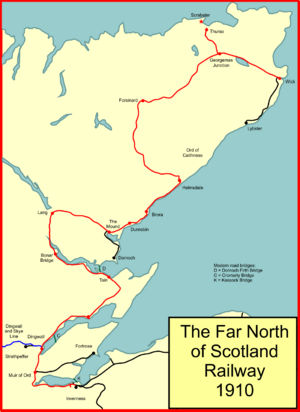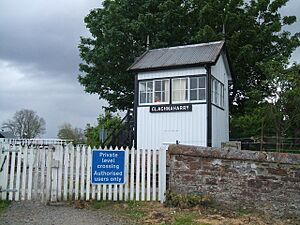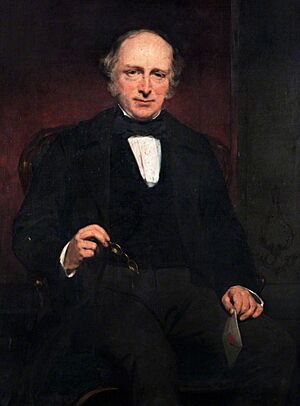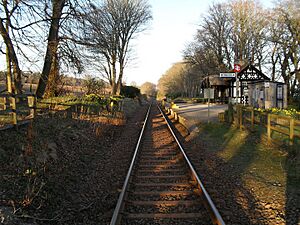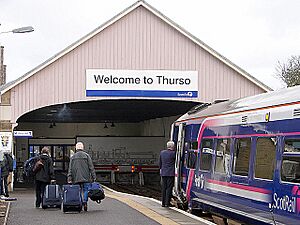History of the Far North of Scotland Railway Line facts for kids
The Far North Line is a railway line in Scotland that connects Inverness to the very north of the country, reaching the towns of Wick and Thurso in Caithness. It's about 161 miles (259 km) long and carries passenger trains regularly.
The line was finished in 1874. It goes around the big water inlets (called firths) north of Inverness, then follows the coast up to Helmsdale. From there, it turns inland through Forsinard before heading back to the coast at Wick and Thurso.
Some stations on the line closed in 1960. Even though new road bridges made car travel much faster, the railway line is still important. It has even seen more use at its southern end because of new houses being built. The original route from 1874 is still used today.
Contents
- Building the Line: Inverness to Dingwall
- Dingwall to Invergordon
- Invergordon to Bonar Bridge
- The Duke of Sutherland's Influence
- The Duke Builds His Own Railway
- Reaching Caithness
- Train Services and Changes
- Smaller Branch Lines
- World Wars and Railway Changes
- British Railways and Modern Times
- The Far North Line Today
- Key Points on the Line
Building the Line: Inverness to Dingwall
The first railway arrived in Inverness in 1855. This line connected Inverness to Nairn, and later to Aberdeen, linking Inverness to the rest of Scotland's railway network.
People soon started thinking about how to build railways further north. It was a tricky area for building tracks because of big rivers like the River Ness, the Caledonian Canal, and large water bodies like the Beauly Firth and the River Conon. Most people lived on the east coast, so any railway needed to go that way.
In 1859, a man named Sir Alexander Matheson suggested building a railway directly from Inverness to Invergordon. Matheson worked very hard, and his plan became the Inverness and Ross-shire Railway. This company got permission to build its line on 3 July 1860. The railway was planned to be 31 miles (50 km) long.
Building the line was done quickly. Bridges were built over the main waterways. For example, the bridge over the Caledonian Canal was a swing bridge, meaning it could open to let boats pass. The Beauly River was crossed by a wooden bridge.
The easier part of the line north of Dingwall was expected to open in April 1862, but there were some delays. An inspector from the government checked the line between Inverness and Dingwall and said it was safe for passengers on 10 June 1862. The line opened the very next day.
The Inverness station was originally built for trains coming from the east, so it was a "dead-end" station. The new Inverness and Ross-shire Railway came from the west. To make it work, most passenger trains from the north would go past the station, then reverse into the platforms. This made it easier for passengers to connect to other trains.
Dingwall to Invergordon
The railway line between Inverness and Dingwall opened to the public on 11 June 1862.
Soon after, several small railway companies east of Inverness joined together to form the Inverness and Aberdeen Junction Railway. While construction continued north of Dingwall, the Inverness and Ross-shire Railway also joined this bigger company on 30 June 1862.
The line between Dingwall and Invergordon was finally ready and opened on 25 March 1863. The Invergordon station was built close to the water, near the Cromarty Firth.
Invergordon to Bonar Bridge
In 1863, permission was given to extend the line further to Bonar Bridge, which was another 26 miles (42 km).
This extension opened to a station called Meikle Ferry on 1 June 1864. This station was about 2+1⁄2 miles (4 km) past Tain, near the Dornoch Firth. Passengers would then take a coach and a ferry to continue their journey north. However, the ferry was almost 1 mile (1.6 km) away from the station, making travel difficult. Meikle Ferry station closed a few years later.
The line reached Bonar Bridge on 1 October 1864. But this station was also a bit far from the actual town of Bonar Bridge. It was located in a village called Ardgay, on the south side of the Kyle of Sutherland.
More railway companies merged, and the Highland Railway was formed on 29 June 1865. This company would operate the Far North Line.
The Duke of Sutherland's Influence
The next part of the Far North Line was built by the Sutherland Railway, also given permission on 29 June 1865. It continued from Ardgay, crossing the river at Invershin to Lairg. Lairg became an important stop for people traveling to the north-western parts of Scotland. The line then turned east to Golspie and Brora on the eastern coast. This new section was almost 33 miles (53 km) long.
The Dukes of Sutherland were very interested in improving their lands. The Third Duke was especially keen on building this railway. The Highland Railway helped pay for some of the construction, but it was very expensive because of the tough landscape.
The Sutherland Railway only managed to open as far as Golspie on 13 April 1868. This was 7 miles (11 km) short of its planned end at Brora. The Highland Railway operated these lines, so it looked like one continuous line from Inverness to Golspie.
In 1868, there was a small "gold rush" near Kildonan, but it didn't amount to much.
The Duke Builds His Own Railway
The Duke of Sutherland noticed that the railway had stopped short of his home, Dunrobin Castle, which was 2 miles (3 km) north of Golspie. So, he got permission to build his own railway line from Golspie to Helmsdale. This was approved on 20 June 1870. Since he owned most of the land, he could start building even before getting official permission. This railway was called the Duke of Sutherland's Railway.
Building this section was mostly easy, except for short parts at each end. The middle section was ready by the end of 1870. It opened on 1 November 1870, running between Dunrobin and a temporary station called West Helmsdale. At first, the line wasn't connected to the Sutherland Railway, so an engine and carriages had to be brought to Dunrobin by road!
On 19 June 1871, the rest of the line was finished, and it opened all the way to Helmsdale. The Highland Railway then took over running the trains. The temporary station at Dunrobin became a private station just for the Duke's estate.
Reaching Caithness
In 1866, a company called the Caithness Railway was allowed to build a line connecting Wick and Thurso. However, the land south of these towns was wild and mountainous, and the company couldn't raise enough money to start building.
Inspired by the Duke of Sutherland's railway, a new company, the Sutherland and Caithness Railway, was formed. It got permission on 13 July 1871. This company planned to follow an inland route north from Helmsdale to connect to Wick and Thurso.
This plan caused a lot of arguments. People in Wick wanted a direct route over the Ord of Caithness, which would have been much shorter and made Wick the main hub. But this route would have had very steep hills. The Duke of Sutherland strongly supported the inland route. In the end, the inland route was chosen, and the Sutherland and Caithness Railway Act was passed.
People in Wick were slow to invest money in the new railway, perhaps because they were upset about their preferred route being rejected. Eventually, the Highland Railway and the Duke of Sutherland invested large sums of money. The line finally opened on 28 July 1874. It connected directly to the Duke of Sutherland's Railway and had stations in both Wick and Thurso. However, neither station was built right at the harbours, even though sea trade was very important.
In July 1874, the Duke of Sutherland himself drove his train into Wick station. The people of Wick were not very enthusiastic. But when he went to Thurso, a huge crowd of 3,000 people, two bands, and a big dinner awaited him!
The Duke asked that any money collected for him be given to the railway workers instead, saying they had "borne the burden and the heat of the day."
An inspector checked the line on 20 July 1874 and said it was safe for passengers. On 28 July 1874, the first public train left Wick "without even a cheer." The railway line from Inverness to Wick and Thurso was now complete. Even though different companies owned parts of it, the Highland Railway operated the entire line as one.
Train Services and Changes
In 1871, there were four trains leaving Inverness each day. After the line opened north of Helmsdale, there were still four trains, including two that went all the way to Wick. There was also a limited service on Sundays.
The Highland Railway was quite old-fashioned in its operations. For example, in 1890, a writer noted that it used old telegraph orders instead of newer safety systems. Many of its trains were "mixed," meaning they carried both goods and passengers, with passenger carriages always at the back.
To make things better, more passing places were added from 1902. In 1913–1914, 6 miles (10 km) of double track was added near Inverness, though the plan to double-track all the way to Dingwall was too expensive.
In summer 1906, a special train called the "Further North Express" ran on Fridays. It was very fast, going non-stop for a long stretch. By 1909, only two trains made the daily trip to Wick and Thurso.
Smaller Branch Lines
The Far North Line went through many quiet areas, so building smaller branch lines wasn't always profitable. Here are some of the more important ones:
Fortrose Branch
This line opened in 1894 to Fortrose from Muir of Ord. It was never very busy. Passenger services stopped in 1951, and the line closed completely in 1960.
Dingwall and Skye Railway
This important line branched off the Far North Line at Dingwall. It was built to reach the West Coast of Scotland, eventually going to Kyle of Lochalsh, which faces the Isle of Skye. The line opened to Stromeferry in 1870 and finally reached Kyle of Lochalsh in 1897. This line is still in use today!
Dornoch Light Railway
The Light Railways Act of 1896 encouraged smaller, local railways. The town of Dornoch felt left out, so the Dornoch Light Railway was formed in 1897. It opened on 2 June 1902, connecting from a junction at The Mound. This was the first "light railway" in the Highlands and cost £28,000 to build. It closed in 1960.
Wick and Lybster Light Railway
Fishing villages south of Wick also wanted a railway connection. The Wick and Lybster Light Railway was formed in 1899 and opened in 1903. It connected some of these villages to Wick. This line closed in 1944.
World Wars and Railway Changes
The First World War (1914-1918) brought huge changes to the Far North Line. A massive naval base was built at Invergordon, and the Cromarty Firth became a major anchorage for ships. The railway had to carry enormous amounts of building materials, supplies for the fleet, and soldiers. This was a huge challenge for a single-track railway with limited space.
Later, Scapa Flow became the home of the Grand Fleet, making traffic even heavier. Coal for the ships and bases, and timber from the local area, also had to be transported. Many skilled railway workers joined the armed forces, making it hard to keep stations and locomotives running.
The Railway Executive Committee helped by lending 19 locomotives from other lines. From 1917, a daily train, nicknamed "The Misery" by sailors, ran from London all the way to Thurso, carrying personnel. Ambulance trains also had to run, especially after the Battle of Jutland and during a flu epidemic in 1918.
After the war, the government decided to group Britain's many railway companies into four larger ones. The Highland Railway became part of the new London, Midland and Scottish Railway (LMS) in 1923. The Far North Line made up a third of the Highland Railway's tracks.
The LMS had more resources and made improvements. Refreshment cars were added to Far North trains in 1923. The "Far North Express" train was also brought back.
The Second World War (1939-1945) again put a huge strain on the Far North Line. However, the LMS, being a larger company, was better prepared with staff and equipment, so the line coped better than in the first war.
British Railways and Modern Times
In 1948, the railways were taken over by the government and became British Railways. Scotland's railways were given their own management.
New, more powerful diesel locomotives started being used on the line from 1958.
Many small, out-of-the-way passenger stations were closed on 13 June 1960. This was because roads had improved, and people relied less on trains in those areas. These closures saved a lot of travel time and money. (Rogart station was reopened later).
In 1981, a big aluminium factory at Invergordon closed, which was a blow to local jobs and freight on the line.
Major new road bridges, like the Kessock Bridge (1982), Cromarty Bridge (1979), and Dornoch Firth Bridge (1991), made road travel much faster north from Inverness. This made the railway less competitive for some journeys.
However, some stations were reopened in the late 20th and early 21st centuries, like Alness (1973), Muir of Ord (1976), Beauly (2002), and Conon Bridge (2013). These reopenings were mainly due to new housing developments and people needing to travel to Inverness for work. In 1977, Bonar Bridge station was renamed Ardgay.
After a big blizzard in 1978, the old telegraph wires along the line were replaced with radio communication between signal boxes. In 1985, a new system called Radio Electronic Token Block (RETB) was introduced. This system shows a "token" (permission to be on a single track) on a screen in the train's cab. Most signals were removed, and points were spring-operated. This system, controlled from Dingwall, saved a lot of staff costs.
From the 1960s, different types of diesel locomotives were used. Passenger trains usually ran three times a day. Northbound trains would split at Georgemas Junction, with one part going to Thurso and the other to Wick.
In the 1990s, passenger services switched to modern multiple-unit trains. The service pattern changed so that trains going to Wick would first go from Georgemas to Thurso, then back to the junction, and finally continue to Wick.
The Far North Line Today
The Far North Line is now seen as a very important service. It connects Inverness with towns where people live and commute, coastal villages in Sutherland, and the towns and ferry ports of Caithness. Many passengers travel to Thurso to catch a NorthLink Ferries boat to Orkney.
ScotRail operates the passenger trains. There are usually four trains each weekday that run all the way between Inverness and Wick. There are also extra shorter trains to Invergordon, Ardgay, or Tain. On Fridays and Saturdays, there's an extra late train to Tain. On Sundays, there's one full service and some shorter trips to Tain.
When going north, the Wick trains go from Georgemas Junction to Thurso and back to the junction, then continue to Wick. The whole journey from Inverness takes about 4 hours and 30 minutes.
While a coach service (the X99) can reach Wick faster, it's less frequent than the train. The coach route also goes over some difficult roads. The Far North Line has seen more passengers in recent years, especially at its main stations.
A group called the Friends of the Far North Line (FoFNL) works to improve services. Their efforts have helped create "Invernet" commuter services and new stations at Beauly and Conon Bridge. Now, they want to improve the tracks and signals. One big idea is a "dynamic passing loop" near Inverness, which would make services more reliable and allow for more frequent trains. They also want to upgrade level crossings to make trains go faster.
Local people are also campaigning to reopen stations like Evanton and Halkirk. There are ideas for a new track that would let trains go to Thurso without having to reverse at Georgemas Junction. Another idea is a local service between Thurso and Wick using a special train. Improving the station at Kinbrace and adding a siding there would help transport timber by rail. A long-term dream is to extend the line from Thurso to Scrabster and to build a "Dornoch Rail Link" to connect the line to Dornoch, saving travel time.
Some stations like Culrain, Invershin, Kildonan, Altnabreac, and Scotscalder are in very remote areas and are not used much. Trains have to slow down at these "request stops" in case someone wants to get on. At Kildonan, which is often the least-used station, there are plans to try a system where passengers press a button to signal they want to board, which could help save time for the trains.
Key Points on the Line
The Far North Line has two main high points:
- County March: This is at the border between Sutherland and Caithness, between Forsinard and Altnabreac, and is 216 metres (708 ft) above sea level.
- Lairg Summit: This is between Lairg and Rogart, and is 149 metres (488 ft) above sea level.
Images


